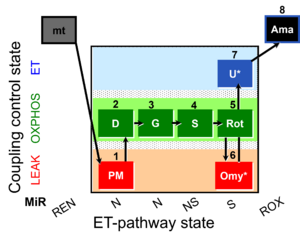Description
Abbreviation: NS(PGM)
Reference: A: SUIT-020 short protocol for simultaneous determination of O2 flux and mitochondrial membrane potential in mitochondrial preparations (isolated mitochondria and tissue homogenate).
SUIT number: D033_1PM;2D;3G;4S;5Rot;6Omy;7U;8Ama
O2k-Application: Fluo
- SUIT-category: NS(PGM)
- SUIT protocol pattern: orthogonal 1PM;2D;3G;4S;5Rot;6Omy;7U;8Ama
This is a protocol to investigate the N- and NS-pathway control state on isolated mitochondria and tissue homogenate. Oligomycin (Omy) is used to induce a LEAK state of respiration via the inhibition of the ATP synthase. Higher concentration of Omy can decreases the ET state initated by an uncoupler, therefore the required concentration of Omy has to be determined. Uncoupler increases the respiration and induces the ET state. Antimycin (Ama), which is an inhibitor of Complex III) blocks the respiration. Addition of PM (Pyruvate & Malate) to the mitochondria leads to the hyperpolarisation of the mt-membrane, while ADP (D) decreases the mt-membrane pontial.Glutamate (G) and Succinate (S) are able to increase further the mt-membrane potential. Rotenone, which is an inhibitor of Complex I, depolarises the mt-membrane. Addition of Omy results in hyperpolarisation owing to the fact that the inhibition of the ATP synthase leads to accumulation of protons in the intermembrane space. Uncoupler depolarises the mt-membrane in a concentration-dependent manner. Antimycin dissipates mt-membrane potential.
Communicated by Huete-Ortega M, Komlodi T and Gnaiger E (last update 2019-02-20)
Steps and respiratory states
| Step | State | Pathway | Q-junction | Comment - Events (E) and Marks (M) |
|---|---|---|---|---|
| 1PM | PML(n) | N | CI | 1PM
|
| 2D | PMP | N | CI | 1PM;2D
|
| 3G | PGMP | N | CI | 1PM;2D;3G
|
| 4S | PGMSP | NS | CI&II | 1PM;2D;3G;4S
|
| 5Rot | SP | S | CII | 1PM;2D;3G;4S;5Rot
|
| 6Omy | SL(Omy) | 1PM;2D;3G;4S;5Rot;6Omy
| ||
| 7U* | SE | S | CII | 1PM;2D;3G;4S;5Rot;6Omy;7S
|
| 8Ama | ROX | 1PM;2D;3G;4S;5Rot;6Omy;7S;8Ama
|
- Bioblast links: SUIT protocols - >>>>>>> - Click on [Expand] or [Collapse] - >>>>>>>
- Coupling control
- Pathway control
- Main fuel substrates
- » Glutamate, G
- » Glycerophosphate, Gp
- » Malate, M
- » Octanoylcarnitine, Oct
- » Pyruvate, P
- » Succinate, S
- Main fuel substrates
- Glossary
Strengths and limitations
- Before you perform this protocol, a calibration wiht the fluoresence dye has to be perfomred.See on our USB: Instrumental Protocols/Fluo calibration.
- It is recommended to run the chemical background without any sample to test the effect of the chemicals on the fluorescence signal. See the protocol on our USB.
- + You get information in one protocol about the NS, S and N-pathway control state.
- - The fluorescence dye (such as Safranin, TMRM etc) can inhibit most porbably the NADH-linked respiration, therefore, the protocol has to be run without using the fluorescence dye. The following protocols can be used: SUIT-020 O2 mt D032.
- - CIV activity and Cytochrome c test cannot be performed together with the fluorescence.
- - Omy concentration has to be determined. Higher concentration of Omy than required can inhibit the ET state.
Compare SUIT protocols
- SUIT-004;SUIT-004 O2 pfi D010: it provides an information about the NS(PM) pathway in the ET state withou the contribution of G.
- SUIT-008;SUIT-008 O2 pfi D014 and SUIT-008 O2 pce D025: it provides information about the NS(PGM) pathway in the OXPHOS and ET-states, but without the addtion of Omy.
- SUIT-011:it provides information about the NS(GM) pathway in the OXPHOS and ET-states, but without the addtion of Omy.
- SUIT-012:it provides information about the N(PGM) pathway in the OXPHOS and ET-states wihtout the contribution of S-pathway and without the addtion of Omy.
- SUIT-014: it is similar protocol to SUIT-020 O2 mt D035, but with the addition of P in the OXPHOS state before S. Omy is not added in the protocol.
References
| Year | Reference | Organism | Tissue;cell | |
|---|---|---|---|---|
| MiPNet20.13 Safranin mt-membranepotential | 2019-06-24 | O2k-FluoRespirometry: HRR and simultaneous determination of mt-membrane potential with safranin or TMRM. | Mouse | Nervous system |
| Krumschnabel 2014 Methods Enzymol | 2014 | Krumschnabel G, Eigentler A, Fasching M, Gnaiger E (2014) Use of safranin for the assessment of mitochondrial membrane potential by high-resolution respirometry and fluorometry. Methods Enzymol 542:163-81. https://doi.org/10.1016/B978-0-12-416618-9.00009-1 | Mouse | Nervous system |
MitoPedia concepts:
SUIT protocol,
SUIT A,
Find
MitoPedia methods:
Fluorometry



